What I Bring Home: On the Cailleach
Still brimming with our fantastic, mysterious journey in Ireland
Dear Friends,
I send Autumn blessings to you all. Before I share my new essay, “What I Bring Home: On the Cailleach and Her Long Lives,” about my recent journey in Ireland and the old woman of the land known as the Cailleach, I want to note just how much I love this season.
Perhaps because I have always been the bookish kid who loved school, every year I welcome the new beginnings that Fall represents. My eyes feast upon the majestic beauty of the shifting slant of daylight and the ever-changing leaves of deciduous trees. I love the feel of the cooling days and the sense of the coming rains. The blessings of Autumn are deep in my bones.
I also want to share exciting news about the publication of a remarkable new book in our writing community. Andrea van de Loo is a wise-woman writer and elder who has pursued a lifelong journey of recovery, spirituality and healing. I was honored to witness in my writing groups some of the earliest pages of her new book, The Pressing Stones: The Healing Journey of a Nazi’s Daughter. She writes of living through trauma as a child during World War II, and awakening to a spiritual life beginning at the Sri Aurobindo Ashram in Pondicherry, India, and much more.
The Pressing Stones is now available for purchase, and can be previewed at her website. For those in the Santa Cruz area, Andrea will offer a Book Signing Event and Presentation on Tuesday, October 29, 2024, 5:00-6:30 pm at the London Nelson Community Center. Please mark your calendars! I look forward to seeing you there.
Thanks for being part of this Writing to Feed the Soul community. Once again, Autumn blessings of the changing light to you.
Carolyn
What I Bring Home
On the Cailleach and Her Long Lives
On our last night in Ireland, I wrote one fateful line in my journal:
“The Cailleach. This time I take her with me.”
I had just offered my final writing prompt and sat back with a sigh. Then I opened my journal and wrote that one line. It was enough. It was prayer. It was statement. It was a new understanding, forged simply and irrevocably in that moment.
Unfolding around me was the last writing circle of our journey, when our group and our writing had become so wizened, gleaming and gorgeous that even I, after all these years, found myself utterly transformed.
I’ve been home now for three weeks, and I still feel the thrum and echo of our Otherworldly and mystical journey. I’ve been floating in this Otherworld, incorporating and digesting all that transpired. And considering all the many ways in which that last line I wrote emerged from our full journey. In truth, it is impossible to capture, though of course that is exactly what writers attempt to do again and again in our devoted and uneven way. Just now in a wisp, I think of a moment on our very first night when I heard myself say that we as a group would be walking the sacred Irish landscape and joining the eons of souls who have walked this land before us and who will walk after us. “We are already part of the ritual story of this place,” I noted. “We have been foreseen.”
I did not know I was going to say that last sentence until it came out of my mouth. I took a quick moment to gaze upon it, and saw that it was true.
Now from my current vantage point, I see us again and again putting our feet and our hands and our kneeling selves and our full bodies upon the living earth. I see us laughing with the Irish people, learning from them, listening to their music. I see us with our amazing guides, walking to holy wells, ancient monasteries, tall standing stones, majestic passage mounds, famous sacred hills and upon great cliffs at the edge of the Atlantic Ocean.
We joined the footsteps of others, alive and dead and those still to come. I can see all the moments when mystical realities coexisted easily with our daily world as we walked these places together. That is, we could feel the Otherworld quite nearby.
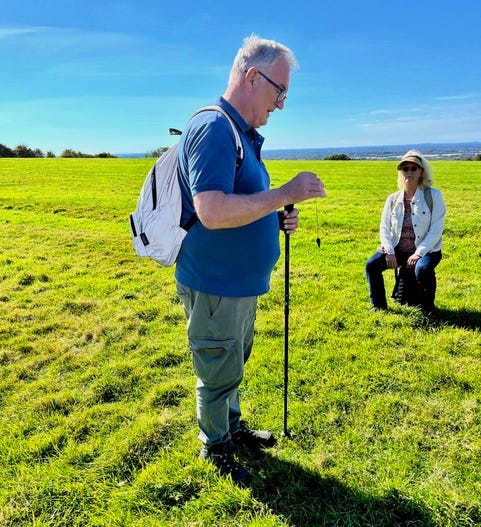
Since I returned, I've been absorbing and integrating all of this— in the midst of the very real world in which we live. We have now passed the Fall Equinox, and the days have begun to shorten and cool. The Middle East explodes and burns ever more violently with unspeakable human death and agony in Gaza and Lebanon. Two huge hurricanes have pounded the US southeast coast in the span of just two weeks, waters have risen and drowned families, homes, forests and rivers, lakes have become unrecognizable dumps of natural and toxic debris. Not to mention the ever more surreal political landscape in the US and throughout the world.
These are our times, and I know we all grapple with how to live, how to stay present and human within ourselves. We live at a historical moment when large systemic and planetary forces—so massive and self-reinforcing that most are beyond our human capacity to manage or effect—are manifesting their own whirling and twisting of our lives. It is quite obvious there are energies beyond the human—karmic, earthy, spiritual, primordial—in which we all exist.
I see now that in many ways this is the story I have brought back with me from Ireland. It is a story of the primordial, the oldest stories we humans have continued to tell each other for thousands of years, from endless time. It is the story of the ancient old woman of Ireland, one of the oldest forces the people tell us about. The Cailleach.
In truth the Cailleach (pronounced “Cal-ee-ach”) has always been part of my journeys to Ireland. Rarely have I gone there without climbing Slieve na Cailleach, “The Hill of the Old Woman” in County Meath (also known as Loughcrew), or visiting “The Hag of Beara,” a large, craggy, magnificent stone often called the fossilized remains of the Cailleach herself, in the southwest.
But this time something new happened, manifested in that last line: “The Cailleach. This time I take her with me.”
Perhaps it was the most ordinary, predictable and time-honored thing possible. This time in Ireland I was silver-haired, 66, past Medicare, planning for Social Security, astonished when I raised my arm and saw on the inside countless tiny wrinkles akin to the bank of a creek when the waters have receded and left their mark. When did these appear? The last time I looked I had my younger, familiar arm. But that is gone, that skin is evolved now into this skin, and the pigment in my hair is gone, and so too the endlesss sense of a body that has no limits. (Though in truth perhaps that has been gone for quite a long time, ah well.)
For many years I have journeyed to Ireland and found Brigit, both goddess and saint. She is my true north, my ancestral guide and the elemental essence of my life and spiritual practice. I light a candle with Her flame in my home and bow to Her reguarly, kneeling my body down to the floor. I collect sacred water from her holy well, and often bless my forehead and eyelids, my throat and heart with it. She has called me and I have answered for a very long time.
As always, this year I brought home sacred water from Brigit’s holy well in Kildare. We visited Solas Bhride near the ancient well, a spiritual center and community devoted to the legacy of Brigit, not to be missed if you ever travel to Ireland. Two of the founders, Phil O'Shea and Rita Minnehan, brought our circle on a pilgrimage, teaching us history and mystery. Their very being showed us what it is to embody a life devoted to activism and justice as well as the sacred. From them I brought back a candle whose wick had been lit from the sacred flame to Brigit which Solas Bhride keeps burning in Kildare. Brigit is elemental to me, in the form of her eternal flame and holy water.
Still now, this time, as I have traveled home from Ireland I have with me—embedded in my very body—the element of Earth. The Hag. The Cailleach. The maker of the land. The great primordial being who pre-exists our embodied lives as Earth creatures. For I am no longer young, and it is not the spring of my life. Those lines on my arm which resemble the bank of a creek show in me the essence of Earth, of which I am made.
And so I begin a new elemental relationship with the ancient old woman of the land, the Cailleach, in this new phase of my life.
I already know her a bit. The Cailleach is one of the oldest mythological figures of Ireland and is connected with the forces shaping the landscape. In numberless Irish folktales she is ageless, fierce, and incredibly strong. She is earthy and straightforward, as easily up for a battle as for a laugh. She is said to be a giantess, incredibly old, primordial, and fast, able to outrun animals and battle men. Again and again she is said to have died into the land of Ireland, and is embedded in many parts of the Irish landscape. She often takes the form of stone.
The Cailleach represents the great primodial forces shaping new mountains and rivers, as our current landscapes are being remade. I do not sense the she is a terrifying earth goddess thundering punishment for our mistreatment of Her, though at times she may seem that way, and in truth this might be quite justified. She is more akin to a powerful, solid grandmother who, without rancor, tells a wailing young one that in the cosmic movement of planets and spheres there are beginnings and ends, causes and outcomes, overreaching and the inevitable balancing, breakdowns and new initiations. This is how it is.
Carina McNally, our guide in the Beara Peninsula in the southwest, is a native of the wild, gorgeous Beara landscape, known for its association with the Cailleach. Carina calls her guiding business “Beara Baoi Tours,” and she spoke to us of the local goddess Baoi, an early version of the Cailleach, who is the earth goddess of that landscape. The legacy of Baoi, she told us, lives on in many local places such as Dursey Island whose Irish name is Oileán Baoi, Dunboy (Dun Baoi), Ballaghboy, and Boharbui. Early names for Baoi meant ‘cow-like one’ and this has influenced the names of the rocks called the Bull the Cow and the Calf which stand in the sea next to Dursey Island.
Carina told us that according to local legend, a large, ancient rock overlooking Coulagh Bay is known as the Hag of Beara, and is considered the fossilised remains of the Cailleach herself, looking out to sea. We walked with Carina to the venerable old stone, mysterious and glorious with her long spectacular view. Carina read us a famous poem about the Cailleach and spoke of her long connections to that place.
I have visited the Hag of Beara many times over thirty years. The craggy, ancient stone with the fantastic view is a frequent destination of tourists and pilgrims alike. The Hag’s stone is always heavy with offerings— coins, ribbons, flowers, jewelry, prayer cards and everything else left by respectful visitors and locals to pay homage to the ancient old woman of the land.
The day we visited the Hag of Beara, Carina told us of a traditional music session in her small village of Ahilies. They meet on Friday nights, and with incredible luck we were there on a Friday. Many of the players are women, she told us, and they call themselves the “Hagilies,” in honor of the Hag of Beara. That evening was a fabulous time-out-of-time that I will write about in more depth in another essay. Suffice it to say we were in the presence of old Ireland, with that transcendent yet utterly earthy love of music, singing, laughter, poetry, rhythm, and the old, old instruments of that place. Hail to the Hagilies!
There are hundreds of different tales told of the Cailleach throughout Ireland and Scotland. In a tale updated to the Christian era, it is said that Saint Patrick himself came upon the Cailleach. He asked the ancient old woman how old she was. She laughed and said he could determine her age by counting the bones she had thrown up into a loft after her many meals. Patrick sent a servant up the loft to throw down the bones, but after a time the bones piled high around the saint, though the servant had hardly made a dent in the pile. Finally Patrick demanded that they be removed, and made the Cailleach disappear, and it was said that was the end of her. But of course that was not the end of her—as the tale itself attests. This story has been told and re-told for well over a thousand years.
Again and again in her adventures the Cailleach dies into the land of Ireland, and remains, embedded in many parts of the Irish landscape. At Slieve na Cailleach (Loughcrew) in County Meath, local lore says that on certain nights one can see her riding her team of horses across the sky. On other nights she likes to sit on a stone up on the hill and smoke her pipe.
One folktale evokes the stories that we who grew up in the Americas may have heard in the indigenous tales here. A man wonders how cold it was on the coldest Bealtaine, or May Day, in very ancient times. The Cailleach is believed to be so old that she knows, but when the man asks her, she tells him she was not there on that coldest May Day, and to ask the Eagle, who is older than herself. But the Eagle also does not know, and says to ask the Otter of the Rock. The man find the Otter, who says to ask the Half-Blind Salmon—who does, in fact, remember that very cold, ancient day. The ice was so thick that the Salmon was beached on the ice, and a seagull poked out its eye, causing it to bleed, which melted the ice and saved the Salmon’s life.
Scholars suggest this tale could be a deep memory of the last Ice Age, at the mythic beginning of time embodied in the rebirth of the Irish landscape after mile-high ice melted about 10,000 years ago. Salmon are in fact one of Earth’s most ancient animals, here about 80 million years, and older than eagles and otters who are about 30 million years old, and infinitely older than humans, our earliest hominid ancestors about 2 million years old. This very old tale of the Cailleach carries a deep understanding: we are the young ones in an old, old place.
We have no choice but to bow to its greater mysteries. The Cailleach carries these stories in ways I can only begin to fathom. I bow to the Cailleach and her knowledge, and ask her to guide me in this next phase of my life, so that I may learn.
The Cailleach. I have brought her back with me from Ireland in a new way. We have begun. Who knows what follows? I sense her looking out to the next adventure, ready to live to the fullest, on and on, to die again and again into the land, and still, to live. I take her hand.
You can find more on Carina McNally here.
There are many books and resources on the Cailleach. My favorite is The Book of the Cailleach: Stories of the Wise Woman Healer by Gearóid Ó Crualaoich.
All photographs by Carolyn Brigit Flynn, except where noted.
I send real gratitude to those of you who became paid subscribers last month when the option became available. For anyone considering this, your assistance makes my work possible, and keeps this newsletter free to all.






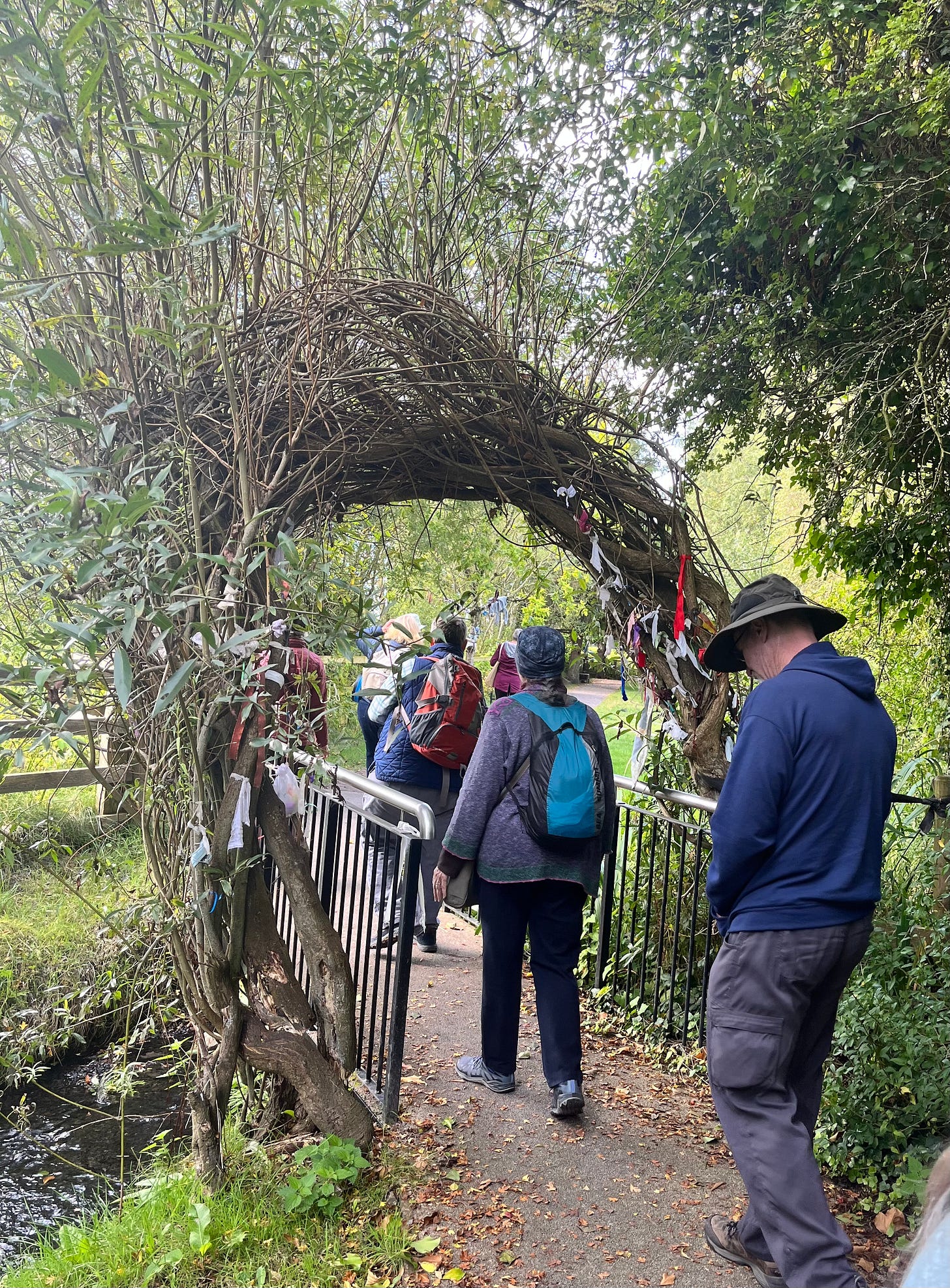


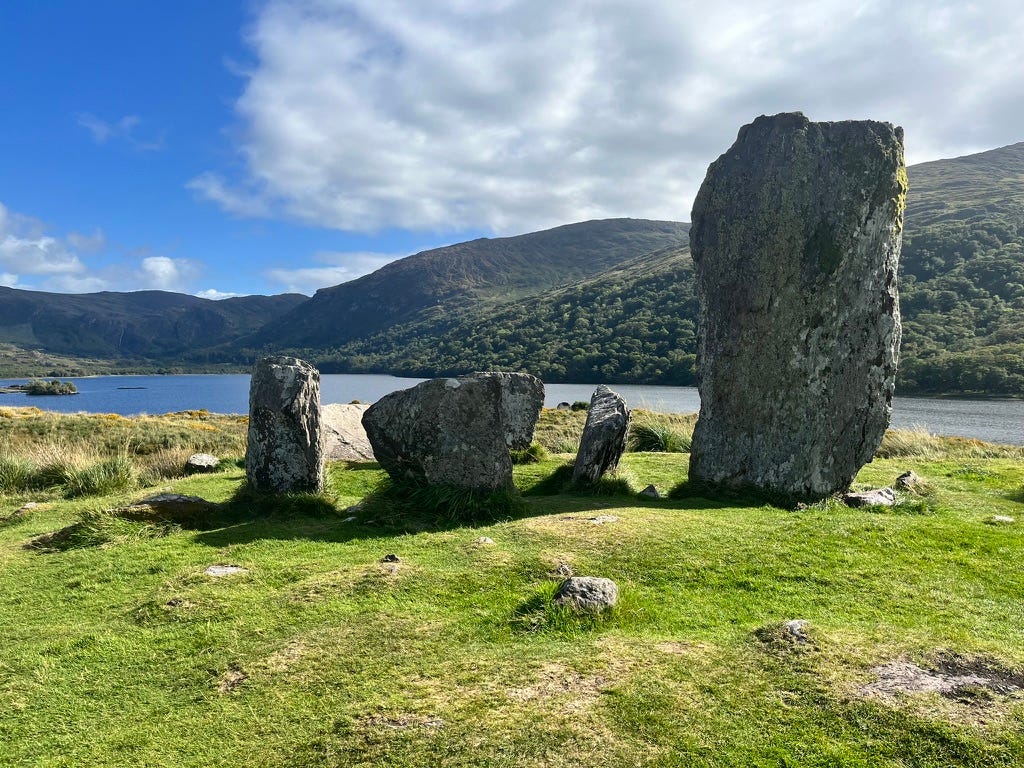
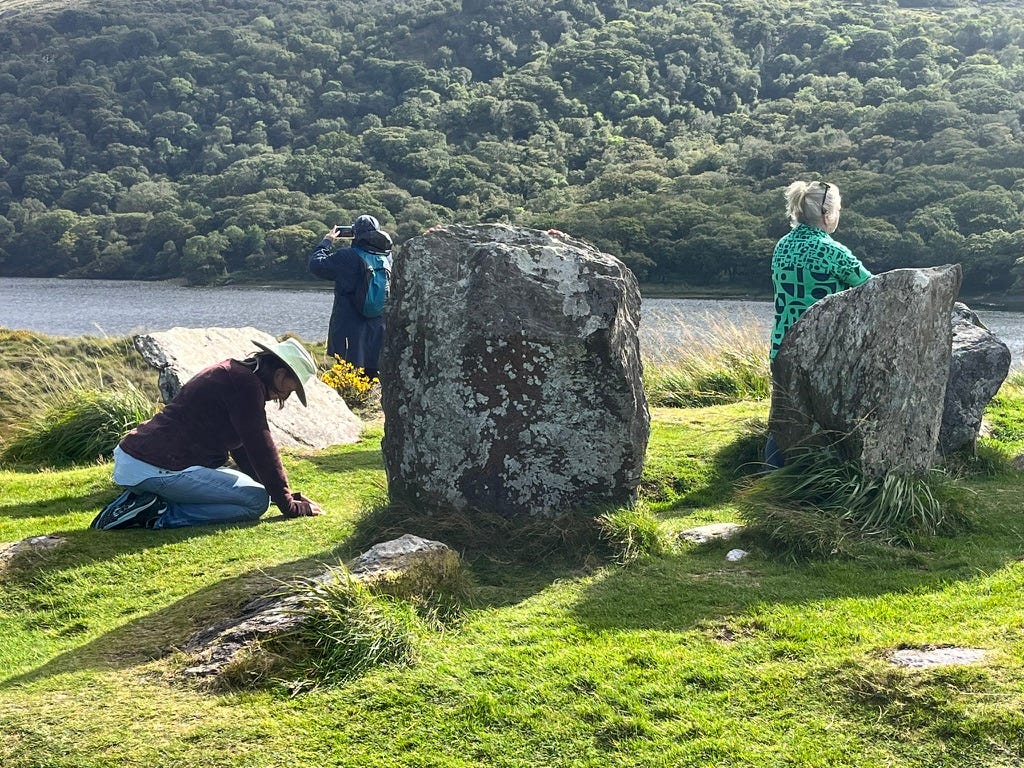
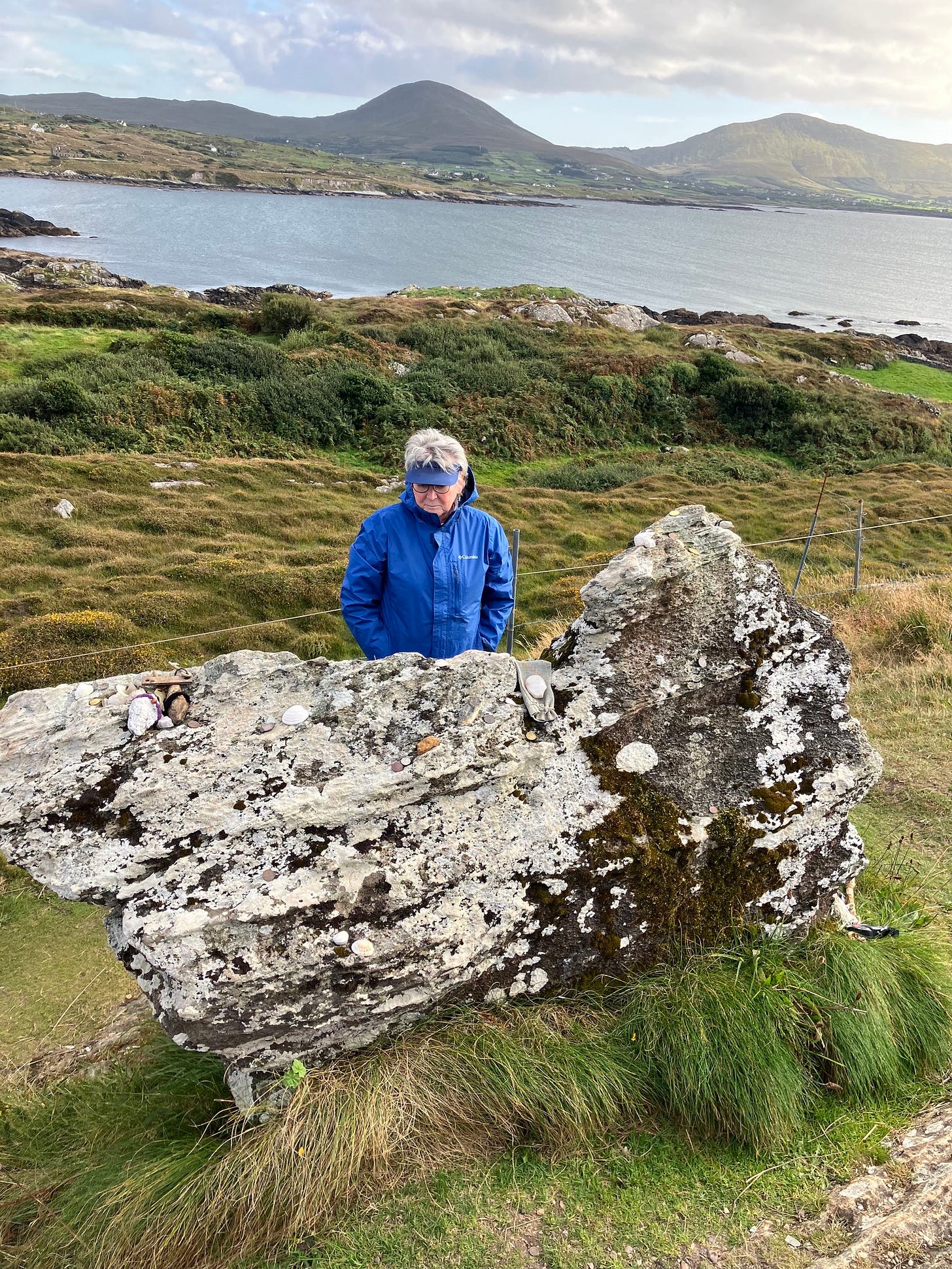



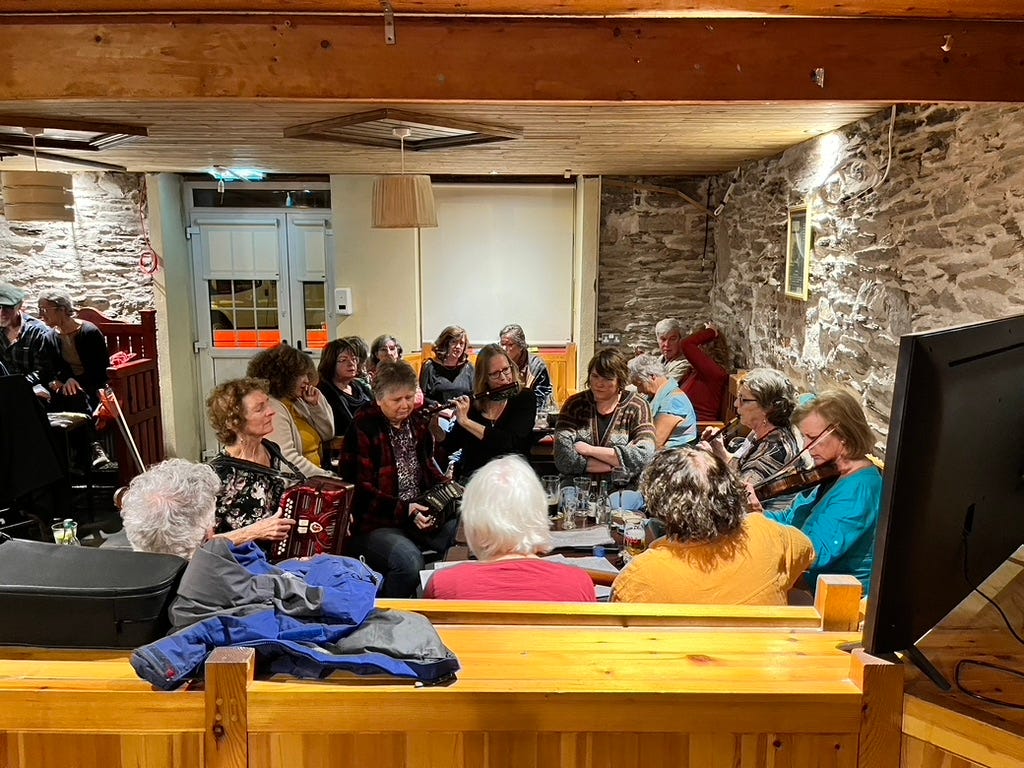
Wondrous Inspiring essay, Carolyn. I was reminded of a journey to Ireland five years ago when my husband and I came upon the stones of Uragh, quite by accident ( though now I wonder about that). The land moved me deeply. The stones spoke to me in their slow circle dance. And so though I wasn't acquainted with Hag Cailleach, I met her and now because of your words, I pray to keep her with me. My deepest gratitude to you.